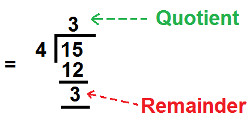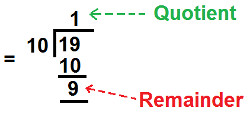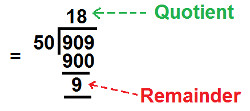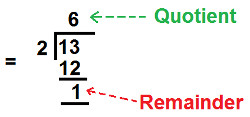Convert the following decimals into Mixed fraction
A) 3.75
B) 1.90
C) 18.18
D) 6.5
E) 1.625 |
A) 3.75
Solution: Follow the steps of conversion:
Step 1: Numerator of fraction is equal to decimal (without the decimal point) and we get: Numerator = 375
Step 2 : Find number of Decimal Place in the given decimal
Decimals Places = two (i.e. digit 7 and 5)
Step 3: Denominator of fraction is equal to 1 followed by as many number of zero as there are decimal place.
As calculated in step 2, there are two decimal place, so we will write two zeros next to digit 1 and we get:
Denominator = 100
| Now, we know that: Fraction = | Numerator
Denominator |
Put the values of numerator and denominator from step 1 & Step 3 and we get:
Now we will convert this fraction into lowest form
Step 4: Find HCF of numerator and denominator of fraction (calculated above)
HCF of 375 and 100 = 25
Step 5: Divide both numerator and denominator by HCF and we get:
| Fraction = | 375 ÷ 25
100 ÷ 25 |
Solve the above division expression and we get:
Now to convert above calculated fraction into mixed fraction, follow the below steps:
Step 6: Divide Numerator by denominator of above calculated fraction i.e.
15
4 |  |
Step 7: Quotient will be Whole Number Part of Mixed Fraction.
so, Quotient = Whole number Part = 3 (calculated above)
Step 8: Remainder will be now be the Numerator of Mixed Fraction.
so, Remainder = Numerator = 3 (calculated above)
Step 9: Denominator remains same, as calculated in step 5.
So, denominator = 4 and we get:
Solution: Follow the steps of conversion:
Step 1: Numerator of fraction is equal to decimal (without the decimal point) and we get:
Numerator = 1.90
Step 2 : Find number of Decimal Place in the given decimal
Decimals Places = two (i.e. digit 9 and 0)
Step 3: Denominator of fraction is equal to 1 followed by as many number of zero as there are decimal place.
As calculated in step 2, there are two decimal places, so we will write two zeros next to digit 1 and we get:
Denominator = 100
| Now, we know that: Fraction = | Numerator
Denominator |
Put the values of numerator and denominator from step 1 & Step 3 and we get:
Now we will convert this fraction into lowest form
Step 4: Find HCF of numerator and denominator of fraction (calculated above)
HCF of 190 and 100 = 10
Step 5: Divide both numerator and denominator by HCF and we get:
| Fraction = | 190 ÷ 10
100 ÷ 10 |
Solve the above division expression and we get:
Now to convert above calculated fraction into mixed fraction, follow the below steps:
Step 6: Divide Numerator by denominator of above calculated fraction i.e.
19
10 |  |
Step 7: Quotient will be Whole Number Part of Mixed Fraction.
so, Quotient = Whole number Part = 1 (calculated above)
Step 8: Remainder will be now be the Numerator of Mixed Fraction.
so, Remainder = Numerator = 9 (calculated above)
Step 9: Denominator remains same, as calculated in step 5.
So, denominator = 10 and we get:
C) 18.18
Solution: Follow the steps of conversion:
Step 1: Numerator of fraction is equal to decimal (without the decimal point) and we get:
Numerator = 18.18
Step 2 : Find number of Decimal Place in the given decimal
Decimals Places = two (i.e. digit 1 and 8)
Step 3: Denominator of fraction is equal to 1 followed by as many number of zero as there are decimal place.
As calculated in step 2, there are two decimal places, so we will write two zeros next to digit 1 and we get:
Denominator = 100
| Now, we know that: Fraction = | Numerator
Denominator |
Put the values of numerator and denominator from step 1 & Step 3 and we get:
Now we will convert this fraction into lowest form
Step 4: Find HCF of numerator and denominator of fraction (calculated above)
HCF of 1818 and 100 = 2
Step 5: Divide both numerator and denominator by HCF and we get:
| Fraction = | 1818 ÷ 2
100 ÷ 2 |
Solve the above division expression and we get:
Now to convert above calculated fraction into mixed fraction, follow the below steps:
Step 6: Divide Numerator by denominator of above calculated fraction i.e.
909
50 |  |
Step 7: Quotient will be Whole Number Part of Mixed Fraction.
so, Quotient = Whole number Part = 18 (calculated above)
Step 8: Remainder will be now be the Numerator of Mixed Fraction.
so, Remainder = Numerator = 9 (calculated above)
Step 9: Denominator remains same, as calculated in step 5.
So, denominator = 50 and we get:
D) 6.5
Solution: Follow the steps of conversion:
Step 1: Numerator of fraction is equal to decimal (without the decimal point) and we get:
Numerator = 65
Step 2 : Find number of Decimal Place in the given decimal
Decimals Places = one only (i.e. digit 5)
Step 3: Denominator of fraction is equal to 1 followed by as many number of zero as there are decimal place.
As calculated in step 2, there is only one decimal place, so we will write one zero next to digit 1 and we get:
Denominator = 10
| Now, we know that: Fraction = | Numerator
Denominator |
Put the values of numerator and denominator from step 1 & Step 3 and we get:
Now we will convert this fraction into lowest form
Step 4: Find HCF of numerator and denominator of fraction (calculated above)
HCF of 65 and 10 = 5
Step 5: Divide both numerator and denominator by HCF and we get:
Solve the above division expression and we get:
Now to convert above calculated fraction into mixed fraction, follow the below steps:
Step 6: Divide Numerator by denominator of above calculated fraction i.e.
13
2 |  |
Step 7: Quotient will be Whole Number Part of Mixed Fraction.
so, Quotient = Whole number Part = 6 (calculated above)
Step 8: Remainder will be now be the Numerator of Mixed Fraction.
so, Remainder = Numerator = 1 (calculated above)
Step 9: Denominator remains same, as calculated in step 5.
So, denominator = 2 and we get:
E) 1.625
Solution: Follow the steps of conversion:
Step 1: Numerator of fraction is equal to decimal (without the decimal point) and we get:
Numerator = 1625
Step 2 : Find number of Decimal Place in the given decimal
Decimals Places = three (i.e. digit 6, 2 and 5)
Step 3: Denominator of fraction is equal to 1 followed by as many number of zero as there are decimal place.
As calculated in step 2, there are three decimal places, so we will write three zeros next to digit 1 and we get:
Denominator = 1000
| Now, we know that: Fraction = | Numerator
Denominator |
Put the values of numerator and denominator from step 1 & Step 3 and we get:
Now we will convert this fraction into lowest form
Step 4: Find HCF of numerator and denominator of fraction (calculated above)
HCF of 1625 and 1000 = 125
Step 5: Divide both numerator and denominator by HCF and we get:
| Fraction = | 1625 ÷ 125
1000 ÷ 125 |
Solve the above division expression and we get:
Now to convert above calculated fraction into mixed fraction, follow the below steps:
Step 6: Divide Numerator by denominator of above calculated fraction i.e.
13
8 |  |
Step 7: Quotient will be Whole Number Part of Mixed Fraction.
so, Quotient = Whole number Part = 1 (calculated above)
Step 8: Remainder will be now be the Numerator of Mixed Fraction.
so, Remainder = Numerator = 5 (calculated above)
Step 9: Denominator remains same, as calculated in step 5.
So, denominator = 8 and we get:
|
Related Question Examples
Convert the following decimals into Mixed fraction
A) 3.75
B) 1.90
C) 18.18
D) 6.5
E) 1.625 |
|






